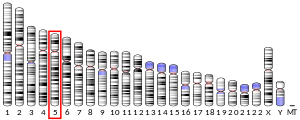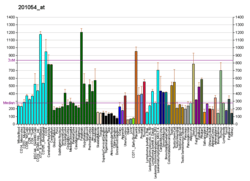HNRNPA0
Heterogeneous nuclear ribonucleoprotein A0 is a protein that in humans is encoded by the HNRNPA0 gene.[5][6]
This gene belongs to the A/B subfamily of ubiquitously expressed heterogeneous nuclear ribonucleoproteins (hnRNPs). The hnRNPs are RNA binding proteins and they complex with heterogeneous nuclear RNA (hnRNA). These proteins are associated with pre-mRNAs in the nucleus and appear to influence pre-mRNA processing and other aspects of mRNA metabolism and transport. While all of the hnRNPs are present in the nucleus, some seem to shuttle between the nucleus and the cytoplasm. The hnRNP proteins have distinct nucleic acid binding properties. The protein encoded by this gene has two repeats of quasi-RRM domains that bind RNAs, followed by a glycine-rich C-terminus.[6]
References
- GRCh38: Ensembl release 89: ENSG00000177733 - Ensembl, May 2017
- GRCm38: Ensembl release 89: ENSMUSG00000007836 - Ensembl, May 2017
- "Human PubMed Reference:". National Center for Biotechnology Information, U.S. National Library of Medicine.
- "Mouse PubMed Reference:". National Center for Biotechnology Information, U.S. National Library of Medicine.
- Myer VE, Steitz JA (Dec 1995). "Isolation and characterization of a novel, low abundance hnRNP protein: A0". RNA. 1 (2): 171–82. PMC 1369071. PMID 7585247.
- "Entrez Gene: HNRPA0 heterogeneous nuclear ribonucleoprotein A0".
Further reading
- Dawson SJ, White LA (1992). "Treatment of Haemophilus aphrophilus endocarditis with ciprofloxacin". J. Infect. 24 (3): 317–20. doi:10.1016/S0163-4453(05)80037-4. PMID 1602151.
- Cross SH, Charlton JA, Nan X, Bird AP (1994). "Purification of CpG islands using a methylated DNA binding column". Nat. Genet. 6 (3): 236–44. doi:10.1038/ng0394-236. PMID 8012384.
- Li SH, McInnis MG, Margolis RL, et al. (1993). "Novel triplet repeat containing genes in human brain: cloning, expression, and length polymorphisms". Genomics. 16 (3): 572–9. doi:10.1006/geno.1993.1232. PMID 8325628.
- Bonaldo MF, Lennon G, Soares MB (1997). "Normalization and subtraction: two approaches to facilitate gene discovery". Genome Res. 6 (9): 791–806. doi:10.1101/gr.6.9.791. PMID 8889548.
- Hillier LD, Lennon G, Becker M, et al. (1997). "Generation and analysis of 280,000 human expressed sequence tags". Genome Res. 6 (9): 807–28. doi:10.1101/gr.6.9.807. PMID 8889549.
- Lai F, Godley LA, Joslin J, et al. (2001). "Transcript map and comparative analysis of the 1.5-Mb commonly deleted segment of human 5q31 in malignant myeloid diseases with a del(5q)". Genomics. 71 (2): 235–45. doi:10.1006/geno.2000.6414. PMID 11161817.
- Rousseau S, Morrice N, Peggie M, et al. (2003). "Inhibition of SAPK2a/p38 prevents hnRNP A0 phosphorylation by MAPKAP-K2 and its interaction with cytokine mRNAs". EMBO J. 21 (23): 6505–14. doi:10.1093/emboj/cdf639. PMC 136943. PMID 12456657.
- Strausberg RL, Feingold EA, Grouse LH, et al. (2003). "Generation and initial analysis of more than 15,000 full-length human and mouse cDNA sequences". Proc. Natl. Acad. Sci. U.S.A. 99 (26): 16899–903. doi:10.1073/pnas.242603899. PMC 139241. PMID 12477932.
- Gerhard DS, Wagner L, Feingold EA, et al. (2004). "The status, quality, and expansion of the NIH full-length cDNA project: the Mammalian Gene Collection (MGC)". Genome Res. 14 (10B): 2121–7. doi:10.1101/gr.2596504. PMC 528928. PMID 15489334.
- Rush J, Moritz A, Lee KA, et al. (2005). "Immunoaffinity profiling of tyrosine phosphorylation in cancer cells". Nat. Biotechnol. 23 (1): 94–101. doi:10.1038/nbt1046. PMID 15592455.
- Andersen JS, Lam YW, Leung AK, et al. (2005). "Nucleolar proteome dynamics". Nature. 433 (7021): 77–83. doi:10.1038/nature03207. PMID 15635413.
- Ong SE, Mittler G, Mann M (2005). "Identifying and quantifying in vivo methylation sites by heavy methyl SILAC". Nat. Methods. 1 (2): 119–26. doi:10.1038/nmeth715. PMID 15782174.





